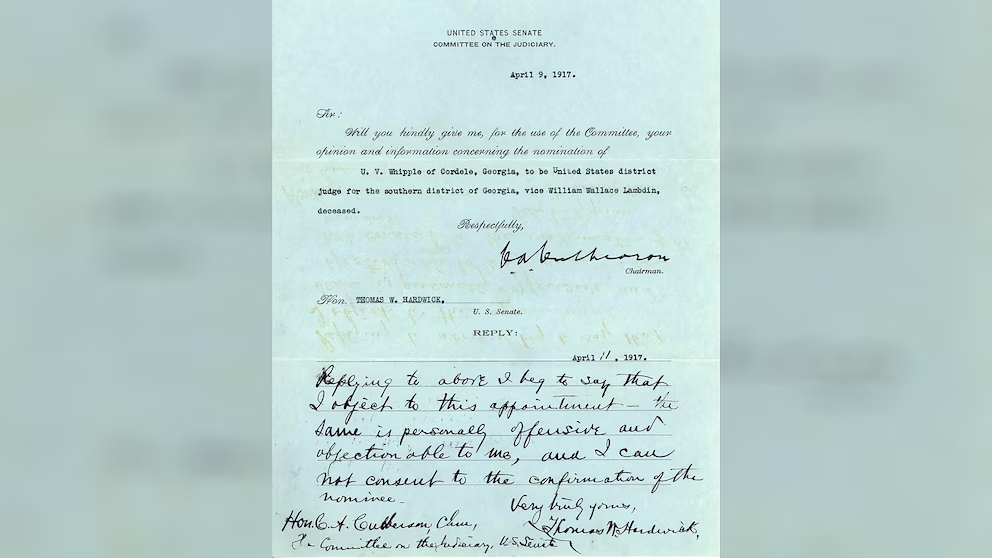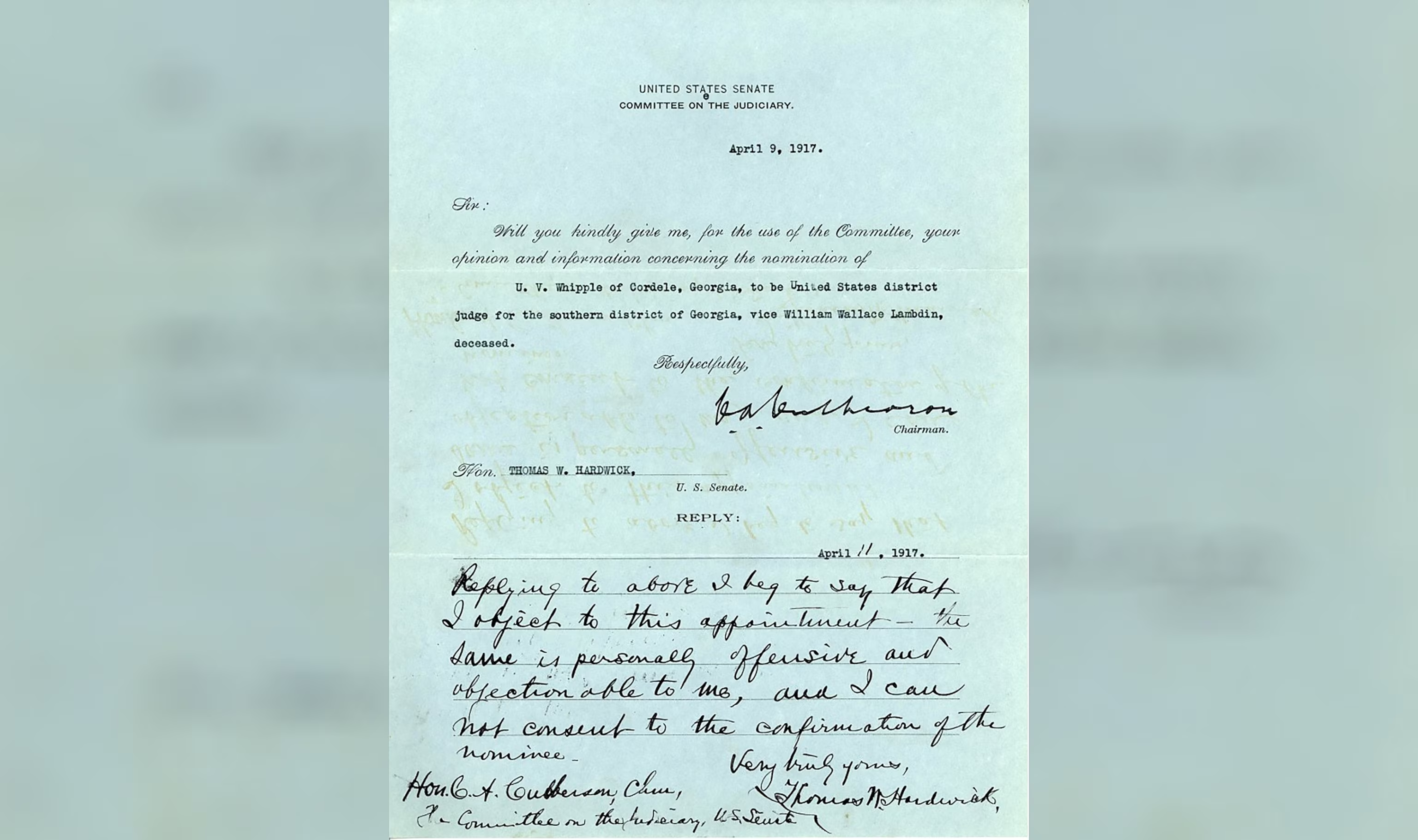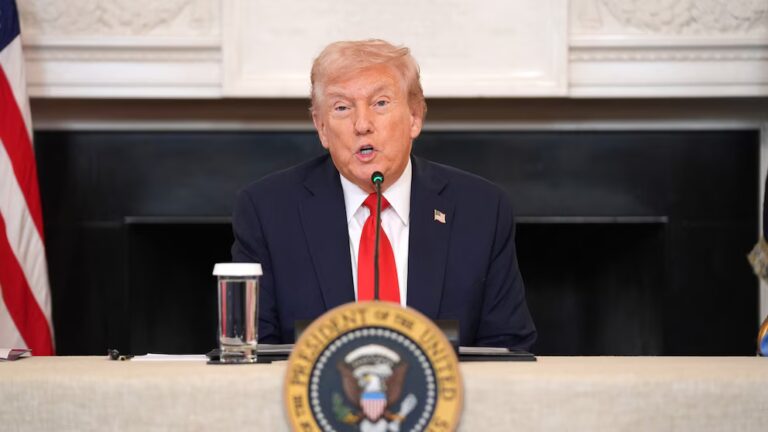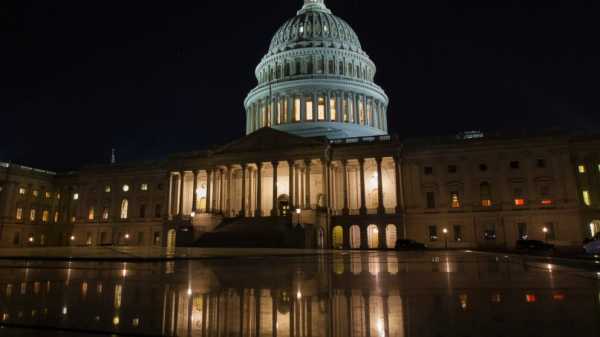
9:07 Former Georgia Sen. Thomas Hardwick stated in a 1917 blue slip that he considered U.V. Whipple, a nominee for the federal bench in Georgia’s Southern District, “personally offensive and objectionable to me.” Courtesy National Archives
President Donald Trump is intensifying his calls for Senate Judiciary Committee Chairman Chuck Grassley to eliminate a longstanding Senate practice that limits the president’s power to appoint judicial nominees.
The tradition in question is the “blue slip” policy, a Senate convention allowing senators to endorse or block nominees for federal judgeships or U.S. attorney roles in their home states.
When a senator approves a nominee, they return their blue slip to the Judiciary Committee. If no blue slip is submitted or if objections are raised, the nomination stalls. In states like New York, some of Trump’s judicial picks have been delayed due to Democratic senators withholding blue slips.
On Sunday evening, Trump reiterated his frustration with this practice in a post on his social media platform.

Sen. Chuck Grassley attends a Senate voting session in the U.S. Capitol on December 5, 2023. Tom Williams/CQ-Roll Call, Inc via Getty Images
“I have a Constitutional Right to appoint Judges and U.S. Attorneys, but that RIGHT has been completely stripped away in states with even one Democrat Senator,” Trump wrote. “This is due to an archaic ‘custom’ called the BLUE SLIP, which Senator Chuck Grassley of Iowa refuses to discard, despite Democrats, including Corrupt Joe Biden (Twice!), repeatedly doing so.”
Trump has previously criticized blue slips and Grassley, but the senator has consistently defended the tradition.
On Monday, Grassley reiterated his stance in a post on X.
“A U.S. Atty or district judge nominee lacking a blue slip won’t secure enough votes for confirmation on the Senate floor or in committee,” Grassley stated. “As chairman, I ensured Pres Trump’s nominees were set for SUCCESS NOT FAILURE. The century-old ‘blue slip’ allows home-state senators to weigh in on US attys & district court judges. Under Biden, Republicans blocked 30 LIBERALS FROM THE BENCH, WHICH PRES TRUMP CAN NOW FILL WITH CONSERVATIVES.”
Despite Grassley’s resistance, Trump continues to push for changes to the process.
Speaking to reporters in the Oval Office on Monday, Trump insisted he would challenge the use of blue slips through legal action but did not specify the target of the lawsuit. He also blamed Grassley for delays in confirming his judicial and U.S. attorney appointments.
“It’s a gentleman’s agreement dating back about 100 years, where a Democratic senator can block a Republican president from appointing a judge or U.S. attorney in their state,” Trump explained. “This isn’t law—it’s an outdated custom. I believe it’s unconstitutional, and I plan to file a lawsuit soon.”
The Senate governs its own procedures and generally sets its own rules and traditions. While blue slips are not formalized in Senate rules, they remain a practice upheld by the Judiciary Committee chairman.

President Donald Trump addresses the press during a meeting with South Korean President Lee Jae Myung in the White House Oval Office, August 25, 2025. Mandel Ngan/AFP via Getty Images
The blue slip procedure dates back to at least 1917, per the Congressional Research Service. Since it’s not part of formal Senate or committee rules, the Judiciary Committee chairman can determine whether an objection or withheld blue slip prevents a nomination from moving forward.
Trump specifically mentioned Jay Clayton, whose nomination as U.S. attorney for the Southern District of New York was recently approved by Manhattan federal judges after being stalled in the Senate due to Minority Leader Chuck Schumer’s refusal to submit a blue slip.
“That’s the only way forward. But normally, you can’t do that because the judges would belong to the opposing party. Jay Clayton was finally approved without senators’ consent,” Trump remarked.
Trump argued that the blue slip system prevents him from appointing Republican judges, claiming he’s restricted to “only nominating Democrat U.S. attorneys.”
“The only candidates I can get approved are Democrats or ineffective Republicans. That’s not what we want. In states with a Democratic senator, I’m blocked from appointing a U.S. attorney of my choice—only a Democrat,” he said.

Then-Sen. Thomas Hardwick of Georgia stated in this 1917 blue slip that he found U.V. Whipple, a nominee for the federal bench in Georgia’s Southern District, “personally offensive and objectionable to me.” Courtesy National Archives
Most Senate Republicans, however, oppose altering the tradition.
Sen. Thom Tillis, R-N.C., a Judiciary Committee member who recently announced he wouldn’t seek re-election, labeled eliminating blue slips as “shortsighted” in an X post Monday.
“Chairman Grassley is a principled conservative committed to keeping far-left judges off the bench. Abolishing blue slips is a reckless, short-term strategy that would enable Democrats to force through extreme liberal judges in Republican-led states in the future,” Tillis wrote. “This is why far-left groups have pushed for years to end the blue slip—Republicans must not fall for it.”
Several Senate Republicans voiced opposition when Trump last sought changes to the blue slip policy in July.
At the time, Majority Leader John Thune showed little support for revising the practice.
“The blue slip process has been a long-standing tradition upheld by both parties, with neither side previously violating it,” Thune noted in July. “I’ll listen to Sen. Grassley and my colleagues, but generally, there’s no appetite here for altering it.”
Sourse: abcnews.go.com






